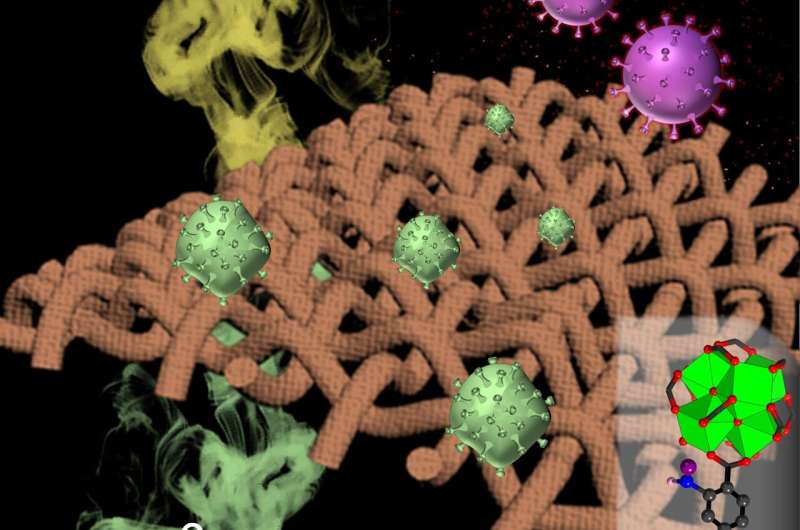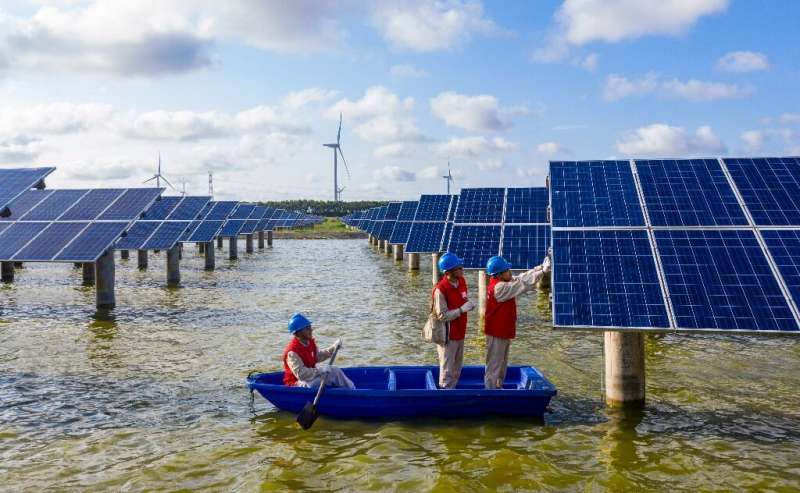Is Dark Matter Real? - with Sabine Hossenfelder
Oct 7, 2021
The Royal Institution
It’s possible that I shall make an ass of myself. But in that case one can always get out of it with a little dialectic. I have, of course, so worded my proposition as to be right either way (K.Marx, Letter to F.Engels on the Indian Mutiny)



by Megan Fellman, Northwestern University

A Northwestern University research team has developed a versatile composite fabric that can deactivate both biological threats, such as the novel coronavirus that causes COVID-19, and chemical threats, such as those used in chemical warfare. A material that is effective against both classes of threats is rare.
The material also is reusable. It can be restored to its original state after the fabric has been exposed to threats by a simple bleach treatment.The promising fabric could be used in face masks and other protective clothing.
"Having a bifunctional material that has the ability to deactivate both chemical and biological toxic agents is crucial since the complexity to integrate multiple materials to do the job is high," said Northwestern's Omar Farha, an expert in metal-organic frameworks, or MOFs, which is the basis for the technology.
Farha, a professor of chemistry in the Weinberg College of Arts and Sciences, is a co-corresponding author of the study. He is a member of Northwestern's International Institute for Nanotechnology.
The MOF/fiber composite builds on an earlier study in which Farha's team created a nanomaterial that deactivates toxic nerve agents. With some small manipulations, the researchers were able to also incorporate antiviral and antibacterial agents into the material.
MOFs are "sophisticated bath sponges," Farha said. The nano-sized materials are designed with a lot of holes that can capture gases, vapors and other agents the way a sponge captures water. In the new composite fabric, the cavities of the MOFs have catalysts that can deactivate toxic chemicals, viruses and bacteria. The porous nanomaterial can be easily coated on textile fibers.
The study was published recently in the Journal of the American Chemical Society (JACS).
The researchers found that the MOF/fiber composite exhibited rapid activity against SARS-CoV-2 and both gram-negative bacteria (E. coli) and gram-positive bacteria (S. aureus). Also, the active chlorine-loaded MOF/fiber composite rapidly degraded sulfur mustard gas and its chemical simulant (2-chloroethyl ethyl sulfide, CEES). The nanopores of the MOF material coated on the textile are wide enough to allow sweat and water to escape.
The composite material is scalable, Farha added, as it only requires basic textile processing equipment currently used by industry. When incorporated into a facemask, the material should be able to work both ways: protecting the mask wearer from virus in his or her vicinity as well as protecting individuals who come into contact with an infected person wearing the mask.
The researchers also were able to develop an understanding of the material's active sites down to atomic level. This allows them and others to derive structure-property relationships that can lead to the creation of other MOF-based composites.
The title of the paper is "Immobilized Regenerable Active Chlorine within a Zirconium-Based MOF Textile Composite to Eliminate Biological and Chemical Threats." Yuk Ha Cheung of The Hong Kong Polytechnic University and Kaikai Ma of Northwestern University are first authors of the paper. Ma also is a co-corresponding author.Hydrogel composite developed to help protective gear rapidly degrade toxic nerve agents
More information: Yuk Ha Cheung et al, Immobilized Regenerable Active Chlorine within a Zirconium-Based MOF Textile Composite to Eliminate Biological and Chemical Threats, Journal of the American Chemical Society (2021). DOI: 10.1021/jacs.1c08576
Journal information: Journal of the American Chemical Society
Provided by Northwestern University

Wageningen University & Research and its partners have developed a new type of aviation fuel that is produced using bio-based waste streams from the agriculture industry.
One of the targets of the Renewable Energy Directive II (RED II) is to increase the use of advanced biofuels in the transport sector, to a minimum of 3.5% of the total biofuel consumption in the EU. Advanced biofuels are fuels that are produced from sustainable biomass and have significantly lower GHG (greenhouse gas) emissions than fossil fuels. The new type of fuel is based on a mixture of acetone and alcohol. While it does not yet meet all requirements, it is getting close. The expectation is that, after some processing steps have been optimized, it will meet all the applicable conditions.
New value chains
Locally produced waste streams from the agriculture or food sector can be used as raw materials in the production of advanced biofuels if they meet stringent sustainability conditions. The BioJet Fuel project is evaluating the complete value and production chains of biofuels from wet organic waste streams for the aviation sector (sustainable aviation fuel, or SAF). The results of this project could represent the first step in the creation of new value chains in the Netherlands, in which biomass and waste streams with a high moisture content from the primary agriculture and food industry are used as raw materials for bioproceses for advanced liquid biofuels.
Cheap waste streams
The raw materials used as model in this project are residual streams from the processing of potatoes. These streams were used as a raw material for the fermentative production of acetone, butanol and ethanol (ABE fermentation). While the composition of the waste streams makes them suitable for fermentation, they are currently used for low-value applications.
Technically feasible
In the approach taken in this project, the mixture of ABE that is produced from the substrate is catalytically converted into hydrocarbons and, after hydrogenation and fractionation, into aviation fuel. Through experimental research, the complete production and value chains for the conversion of wet agricultural waste streams into fuel have been shown to be technically feasible. A techno-economic assessment and a life cycle analysis (LCA) of the value chain have also been carried out.
The feedstock in this project is potato waste streams, which are currently sold as low-value cattle feed, or are converted through anaerobic digestion into methane. However, a commercial process will also require additional feedstocks, to achieve sufficient volume. Possible feedstocks that meet the criteria of Annex IX of the RED are lignocellulosic biomass and waste streams from the paper industry.
by Michael Phillis

After water levels at a California dam fell to historic lows this summer, the main hydropower plant it feeds was shut down. At the Hoover Dam in Nevada—one of the country's biggest hydropower generators—production is down by 25%. If extreme drought persists, federal officials say a dam in Arizona could stop producing electricity in coming years.
Severe drought across the West drained reservoirs this year, slashing hydropower production and further stressing the region's power grids. And as extreme weather becomes more common with climate change, grid operators are adapting to swings in hydropower generation.
"The challenge is finding the right resource, or mix of resources, that can provide the same energy and power outputs as hydro," said Lindsay Buckley, a spokesperson for the California Energy Commission.
U.S. hydropower generation is expected to decline 14% this year compared with 2020, according to a recent federal forecast. The projected drops are concentrated in Western states that rely more heavily on hydropower, with California's production expected to fall by nearly half.
The reductions complicate grid operations since hydropower is a relatively flexible renewable energy source that can be easily turned up or down, experts say, such as in the evenings when the sun goes down and solar energy generation drops.
"Hydro is a big part of the plan for making the whole system work together," said Severin Borenstein, a renewable energy expert at the University of California, Berkeley and board member of the California Independent System Operator, which manages the state's electric grid.
Borenstein noted that hydropower is important as the state works to build out its electricity storage options, including by installing batteries that can dispatch energy when it is needed.
Ben Kujala of the Northwest Power and Conservation Council, which handles power planning for the Columbia River basin, also noted that grid operators have adapted how they deploy hydropower in recent years to ensure that it complements solar and wind energy.
Power grids linking Western regions also offer some relief. While California can face multi-year stretches of dry weather, the Pacific Northwest usually gets enough precipitation in the winter to recover and produce hydropower to export.
But this year, the Northwest was also hit by extreme heat and less precipitation, according to Crystal Raymond, a climate change researcher at the University of Washington. While energy planners account for drought years, Raymond said climate change over the long term may further reduce the amounts of melting snow in mountains that fill reservoirs in the spring.
In August, California officials shut down the Edward Hyatt hydropower plant for the first time in its 60-year history after water levels at Lake Oroville sank to historic lows. The plant can produce enough power for up to 750,000 homes, but typically operates at lower levels.
At Lake Powell on the Arizona-Utah border, federal officials recently said there is a 34% chance that the Glen Canyon Dam won't be able to produce power at some point in 2023, up from a 3% chance for next year, if extreme drought persists.
Declines in hydropower production in California this summer coincided with heat waves, forcing the state to buy extra power. To prevent outages in late September, state officials said they were deploying temporary emergency generators.
"The drought did compound the difficulty of meeting demand," said Jordan Kern, an energy and water systems expert at North Carolina State University.
In some Northwestern states, hydropower production has reverted closer to normal levels after dipping just below their 10-year ranges earlier this year. California's hydropower levels remained at the bottom of the state's 10-year range through June. Federal forecasts says much of the West is likely to continue to see drought conditions through the end of the year.
Declines in hydropower production mean production bumps for other energy sources. Natural gas power is expected to rise 7% in California and 6% in the Northwest this year over last, according to federal forecasts. Coal generation is forecast to rise 12% in the Northwest.
The California Air Resources Board says the state has been able to continue reducing the electricity sector's greenhouse gas emissions despite swings in hydropower generation in recent years.
© 2021 The Associated Press. All rights reserved. This material may not be published, broadcast, rewritten or redistributed without permission.
by Catherine Hours

The transition towards cleaner energy has made progress but not quick enough to limit global warming to well below 2 degrees Celsius, as agreed in the 2015 Paris climate agreement.
While the COVID-19 pandemic initially caused a drop in greenhouse gas emissions as economic activity dropped, the pandemic may not have accelerated the shift to renewables:
Renewables boom
Renewables are now the number two source of electricity in the world with a 26 percent share in 2019—behind coal, but ahead of natural gas and nuclear.
Wind and solar power have grown at annual rates of 22 and 36 percent, respectively as their prices have plunged since 1990.
Even during the pandemic, 26 gigawatts (GW) of capacity was added last year, setting a new record, according to the International Renewable Energy Agency (IRENA).
But the use of fossil fuels in final consumption (electricity, transportation fuel, heating and factory production) has held steady.
At 80.3 percent in 2009, it was still 80.2 percent in 2019, as overall energy consumption increases thanks to population growth as well as rising incomes in Asia.
Sharp turn by automakers
Pushed by tighter pollution regulations, leading automakers are aiming to scrap internal combustion engines within the next decade or sharply cut their production as they shift towards all-electric futures.
Roads are still crowded with polluting cars: Electric vehicles only make up five percent of new units sold.
The International Energy Agency says consumers continue to prefer big SUVs—they accounted for 42 percent of sales in 2020—that pollute more than smaller models.
Hydrogen
From Australia to China to the EU, more and more nations are setting their sites on green hydrogen for lorries and factories.
While burning hydrogen as a fuel emits just water, most of the gas is made in a process that produces harmful emissions.
Finding cost effective ways to produce hydrogen cleanly and developing the infrastructure for its use will require more effort, with the IEA urging a quadrupling of investments in the sector.

Carbon pricing
In mid-2020 some 44 countries and 31 cities accounting for 60 percent of global economic output had carbon pricing (taxes or quotas) schemes in place, according to the I4CE think tank.
Carbon prices aim to make polluters pay for some of the social costs of emissions such as health care costs due to poor air quality and crop damage due to climate change.
Experts say the price needs to be between $40 and $80 per tonne of CO2 to push polluters to increase efficiency or shift to renewable energy sources.
However, the price is under $10 for 75 percent of covered emissions.
Pandemic investment
The Ren 21 think tank said the coronavirus pandemic provided an opportunity to shift public policy, but countries provided six times as much investment money to fossil fuel than renewable energy projects in their economic recovery plans.
After dropping by seven percent thanks to the pandemic, CO2 emissions are expected to hit new records by 2023 if those investments are not shifted.
Emerging difficulties
Investment in renewable energy has been sliding for several years in emerging and developing nations except for China, and the coronavirus pandemic has done nothing to change the situation.
These countries hold two-thirds of the world's population and are responsible for 90 percent of the growth in emissions, but they are receiving only 20 percent of investments into clean energy, according to the IEA.
King coal still reigns
Long ago baptised "king coal" for its outsize role in powering the world economy, the fuel remains in wide use in Asia to meet the growing needs for electricity in the region.
The global economic recovery means that coal demand is likely to surpass its 2019 level and thus also retain its crown of being the leading source of greenhouse gas emissions.
China, which has been a major financer of coal projects in other nations, announced in September it is halting the practice.
© 2021 AFP
The race to save indigenous languages using automatic speech recognition
by Tanner Stening, Northeastern University

Michael Running Wolf still has that old TI-89 graphing calculator he used in high school that helped propel his interest in technology.
"Back then, my teachers saw I was really interested in it," says Running Wolf, clinical instructor of computer science at Northeastern University. "Actually a couple of them printed out hundreds of pages of instructions for me on how to code" the device so that it could play games.
What Running Wolf, who grew up in a remote Cheyenne village in Birney, Montana, didn't realize at the time, poring over the stack of printouts at home by the light of kerosene lamps, was that he was actually teaching himself basic programming.
"I thought I was just learning how to put computer games on my calculator," Running Wolf says with a laugh.
But it hadn't been his first encounter with technology. Growing up in the windy plains near the Northern Cheyenne Indian Reservation, Running Wolf says that although his family—which is part Cheyenne, part Lakota—didn't have daily access to running water or electricity, sometimes, when the winds died down, the power would flicker on, and he'd plug in his Atari console and play games with his sisters.
These early experiences would spur forward a lifelong interest in computers, artificial intelligence, and software engineering that Running Wolf is now harnessing to help reawaken endangered indigenous languages in North and South America, some of which are so critically at risk of extinction that their tallies of living native speakers have dwindled into the single digits.
Running Wolf's goal is to develop methods for documenting and maintaining these early languages through automatic speech recognition software, helping to keep them "alive" and well-documented. It would be a process, he says, that tribal and indigenous communities could use to supplement their own language reclamation efforts, which have intensified in recent years amid the threats facing languages.
"The grandiose plan, the far-off dream, is we can create technology to not only preserve, but reclaim languages," says Running Wolf, who teaches computer science at Northeastern's Vancouver campus. "Preservation isn't what we want. That's like taking something and embalming it and putting it in a museum. Languages are living things."
The better thing to say is that they've "gone to sleep," Running Wolf s
And the threats to indigenous languages are real. Of the roughly 6,700 languages spoken in the world, about 40 percent are in danger of atrophying out of existence forever, according to UNESCO Atlas of Languages in Danger. The loss of these languages also represents the loss of whole systems of knowledge unique to a culture, and the ability to transmit that knowledge across generations.
While the situation appears dire—and is, in many cases—Running Wolf says nearly every Native American tribe is engaged in language reclamation efforts. In New England, one notable tribe doing so is the Mashpee Wampanoag Tribe, whose native tongue is now being taught in public schools on Cape Cod, Massachusetts.
But the problem, he says, is that in the ever-evolving field of computational linguistics, little research has been devoted to Native American languages. This is partially due to a lack of linguistic data, but it is also because many native languages are "polysynthetic," meaning they contain words that comprise many morphemes, which are the smallest units of meaning in language, Running Wolf says.
Polysynthetic languages often have very long words—words that can mean an entire sentence, or denote a sentence's worth of meaning.
Further complicating the effort is the fact that many Native American languages don't have an orthography, or an alphabet, he says. In terms of what languages need to keep them afloat, Running Wolf maintains that orthographies are not vital. Many indigenous languages have survived through a strong oral tradition in lieu of a robust written one.
But for scholars looking to build databases and transcription methods, like Running Wolf, written texts are important to filling in the gaps. What's holding researchers back from building automatic speech recognition for indigenous languages is precisely that there is a lack of audio and textual data available to them.
Using hundreds of hours of audio from various tribes, Running Wolf has managed to produce some rudimentary results. So far, the automatic speech recognition software he and his team have developed can recognize single, simple words from some of the indigenous languages they have data for.
"Right now, we're building a corpus of audio and texts to start showing early results," Running Wolf says.
Importantly, he says, "I think we have an approach that's scientifically sound."
Eventually, Running Wolf says he hopes to create a way for tribes to provide their youth with tools to learn these ancient languages by way of technological immersion—through things like augmented or virtual reality, he says.
Some of these technologies are already under development by Running Wolf and his team, made up of a linguist, a data scientist, a machine learning engineer, and his wife, who used to be a program manager, among others. All of the ongoing research and development is being done in consultation with numerous tribal communities, Running Wolf says.
"It's all coming from the people," he says. "They want to work with us, and we're doing the best to respect their knowledge systems."
WHITE SUPREMACIST MEDICINE
Minority children are more likely than white children to die after surgery
by American Society of Anesthesiologists

Minority children die after surgery at higher rates than white children regardless of socioeconomic status (SES), according to a first-of-its-kind study being presented at the ANESTHESIOLOGY 2021 annual meeting.
"Given that minority children—especially Black and Hispanic children—are more likely to be born into poverty than white children, the common narrative is that the difference in SES is a primary reason for the racial disparity in the rate of post-surgical death," said Brittany L. Willer, M.D., lead author and pediatric anesthesiologist at Nationwide Children's Hospital, Columbus, Ohio. "Though white children belonging to families of higher SES benefit from improved health outcomes in comparison to their peers in lower SES families, this study demonstrates that a 'wealth advantage' does not exist for minority children."
In the study, researchers compared the post-surgical death rate of minority children to white children based on their SES. They used the median household income of the specific ZIP code the child lived in to determine which quartile of SES the child should be assigned—high, high/middle, low/middle, low—and found that belonging to a higher SES did not significantly lower the postoperative mortality rates for minority children compared to poorer minority children.
The researchers analyzed post-surgical deaths (i.e., children who died while still in the hospital) from the national Kids' Inpatient Database for 2006, 2009 and 2012. They compared the same number of white children to a matched group of children for each of the minority groups. They analyzed the surgical outcomes of 79,280 Black children to 79,280 white children, and used the same 1:1 ratio to compare white children to Native American children (5,344), Asian children (17,508) and Hispanic children (116,125).
Overall, minority children were more likely to die after surgery than white children, even if they were from the same SES. For example, Black children in the lowest three income quartiles were 1.5 times more likely to die after surgery than white children in the lowest three income quartiles. While the risk of death appeared to be somewhat less for Black children in the top income quartile compared to Black children in the lowest quartiles, the difference was not statistically significant. The researchers found similar patterns in other minority children, which indicated there was no evidence that being in the wealthiest income group led to a reduction in excess death risk for any of the minority groups.
Dr. Willer notes that the absence of improved health outcomes among minority children of higher SES is also seen in adults and may provide evidence of the cost of upward mobility for minorities. Additionally, systemic inequities and chronic prejudice contribute to increased rates of depression, obesity and chronic stress among minorities of all SES levels. Further, poverty-related factors for those in the lower SES quartiles still need to be directly addressed, including reduced parental health literacy, hazardous environmental exposures and poor access to resources.
"Equitable and personalized surgical care should be the ultimate goal for children of all SES classes, races and ethnicities," said Dr. Willer. "Physician anesthesiologists and surgeons can do a number of things to achieve surgical equity, including following clinical guidelines to reduce disparities, using enhanced recovery after surgery protocols to standardize delivery of perioperative care, and employing race-specific surgical risk models to counsel families whose children are having surgery. Most importantly, we need to be aware of our implicit biases and practice strategies to address them."
